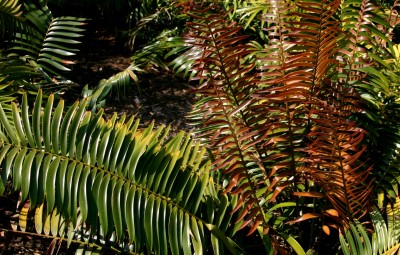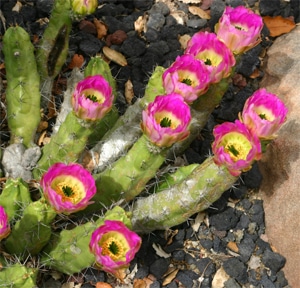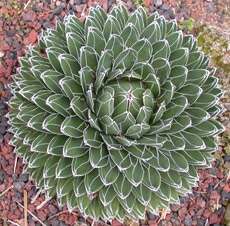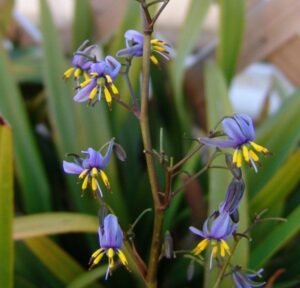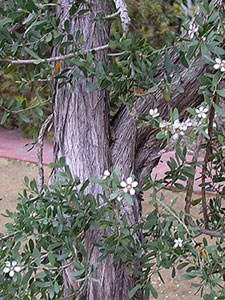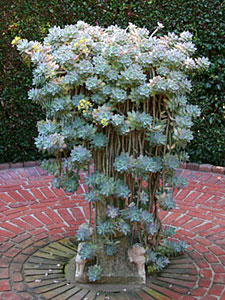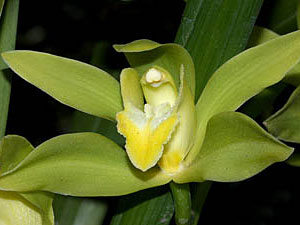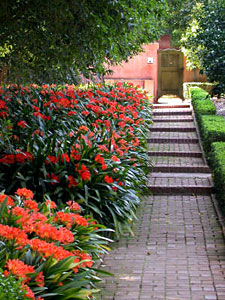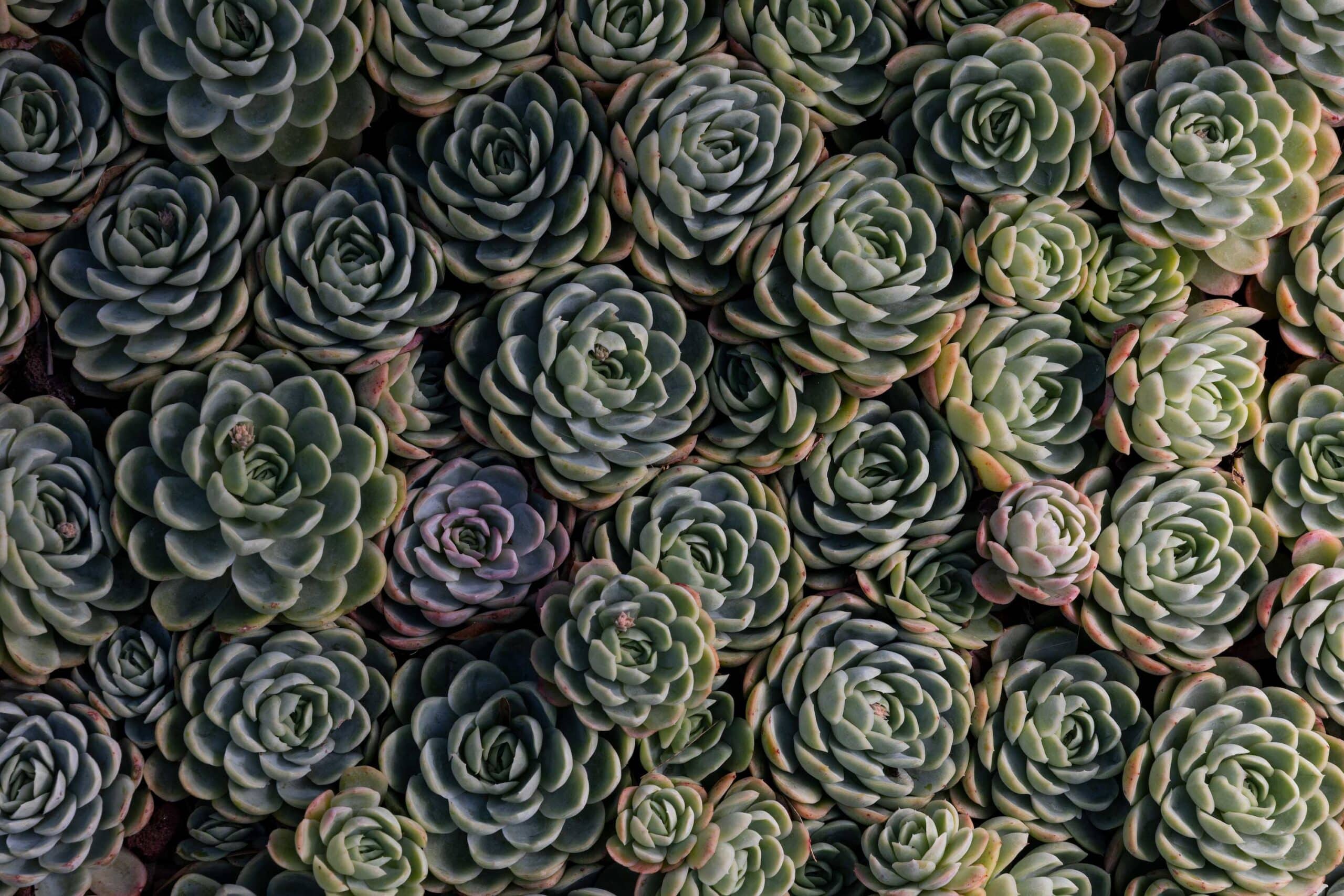
Plant Highlights
Plant Highlights
-
Opuntia robusta
Highlight Month:
May
Nativity:
Northern and Central Mexico
Growth Habit:
This prickly pear cactus has large, round “pads” that are actually the flattened stems. Covered with a whitish wax, the overall appearance is gray green. Yellow flowers (and the resultant reddish purple fruits) are formed on the edges of the topmost pads. Plants can grow to many feet in height and width and eventually form thickets.
Growing Requirements:
Full sun and well-drained soil are needed. Plants are frost tender, but can be grown in pots and wintered indoors if kept dry.
Features:
Both pads and fruits are edible, although care must be taken to remove the one to two inch long spines.
Where at Lotusland:
In the Cactus Garden and the Main Drive.
-
Acer palmatum cultivars
Japanese maple
Highlight Month:
May
Nativity:
Japan
Growth Habit:
Japanese maples can grow to become rounded trees with a height of thirty feet. Trees in the Japanese Garden have been carefully pruned in the niwaki style and may be only ten to twelve feet (or less) in height. All are deciduous and some have reddish new foliage (pictured), while others have brilliant fall colors.
Growing Requirements:
Tolerant of shade, Japanese maples will also grow in full sun. Regular water and fertilizer are required. Excessive heat and alkaline soils will cause the leaves to burn at the edges.
Features:
There are over a thousand different cultivars of Japanese maple. Chosen for their foliage colors, bark characteristics and even fruit attributes, they are a quintessential element of any Japanese style garden.
Where at Lotusland:
Japanese Garden
-
Ceratozamia latifolia
Highlight Month:
May
Nativity:
Mexico
Growth Habit:
After many years of growth, this cycad may have a short caudex above ground. Typically the caudex remains below the surface of the soil and the rosette of leaves seems to rise directly from the ground. The leaves appear in “flushes” of several leaves at a time, usually once a year. They are tough and leathery.
Growing Requirements:
Partial shade and moist, humus-rich soil.
Features:
The new leaves emerge a bronze shade and gradually turn glossy green.
Where at Lotusland:
Cycad Garden
-
Echinocereus pentalophus
ladyfinger cactus
Highlight Month:
May
Nativity:
Texas to Northern Mexico
Growth Habit:
This cactus has multiple stems less than a foot in height. The stems are sparsely spiny and have 5 to 7 ribs.
Growing Requirements:
Ladyfinger cactus requires full sun and well-drained soil. It is only moderately frost tolerant and can be damaged at temperatures below 20 degrees.
Features:
The ladyfinger cactus eventually forms a large clump of stems. When it blooms in late spring, the flowers are large and very showy.
Where at Lotusland:
Main Drive
-
Agave victoriae-reginae
Queen Victoria agave
Highlight Month:
April
Nativity:
NE Mexico (Coahuila, Durango, Nuevo León)
Growth Habit:
This geometrically pleasing agave grows in a tight rosette with distinctive white markings on its leaves. It is native to the Chihuahuan Desert in Mexico where it grows in limestone between 4,000-5,000’ in elevation. After reaching a considerable age, this species will produce yellow to reddish-purple flowers on an impressive 15’ spike. It rarely offsets and dies after flowering so new plants must be propagated via seed or tissue culture.
Growing Requirements:
Full sun, well drained soil with little water.
Features:
Due to its small size and slow growth, this agave makes an excellent container plant, though keep it away from walkways since each leaf is tipped with one very sharp spine. The specific epithet honors Queen Victoria, ruler of Great Britain and Ireland from 1837-1901.
Where at Lotusland:
A planting of A. victoriae-reginae grows on the slope along the path to the Water Garden.
-
Dianella tasmanica
Australian iris, flax lily
Highlight Month:
April
Nativity:
D. tasmanica is native to SE Australia including Tasmania.
Growth Habit:
A clumping perennial with strap-shaped leaves growing 3-4 feet tall and 2-3 feet wide. It spreads rapidly by underground rhizomes.
Growing Requirements:
It will grow in sun to partial shade; it needs more shade in hot climates. It can be drought-tolerant but the foliage will look better with some additional water. Grows best in well-drained soil.
Features:
Clusters of small blue star-shaped flowers in spring are followed by bright blue berries which hang on their stems for over a month. There is a cultivar ‘Variegata’ that has white-striped leaves.
Where at Lotusland:
Flax lily is planted in many of the beds bordering the Visitor’s Center parking lot in the Australian Garden.
-
Leptospermum laevigatum
Australian or coastal tea tree
Highlight Month:
April
Nativity:
Coastal dunes of southeastern Australia
Growth Habit:
Leptospermum laevigatum can be easily trained into different forms. If the lower growth is pruned away, it will develop into a small tree 30 feet tall by 20 feet wide. Young plants can be placed close together to make a hedge or windbreak. They can also be trained over a fence or arbor. There are a few cultivars including ‘Reevesii’, a compact form growing to only 5 ft. x 5 ft., and ‘Raelene’ which has variegated foliage.
Growing Requirements:
Australian tea tree does best in full sun to partial shade, and needs good drainage in a slightly acid soil or neutral soil. If planted in heavy clay soils it may become chlorotic or develop root rot. Once established it is a drought tolerant and salt tolerant plant. Cold hardiness is around 20 degrees.
Features:
The finely textured olive-green foliage is arranged on weeping branches. Small white flowers bloom in spring. The trunk has unusual shaggy, fibrous bark and older specimens develop twisting, gnarled branches which spread out along the ground. The commonly used tea tree oil is not derived from this species, but instead from Melaleuca alternifolia.
Where at Lotusland:
The Tea Tree Arbor at the Visitor’s Center. There are also some specimens in the surrounding Australian Garden.
-
xGraptosedum
Highlight Month:
April
Nativity:
Garden Origin
Growth Habit:
This succulent plant is a hybrid between Graptopetalum paraguayense and Sedum adolphi. It combines the gray-green rosettes of a Graptopetalum with the yellow flowers of Sedum.
Growing Requirements:
Full sun or partial shade and well-drained soil are needed. Plants are frost tender, but can be grown in pots and wintered indoors if kept dry.
Where at Lotusland:
This specimen is planted in an antique baptismal font on the Parterre.
-
Cymbidium lowianum var. concolor
Highlight Month:
April
Nativity:
Assam to China (S. Yunnan) and N. Indo-China
Growth Habit:
This orchid in the genus Cymbidium has long arching sprays of medium-sized flowers. The plant eventually forms large clumps and blooms for several months in spring.
Growing Requirements:
Partial shade and typical orchid bark as a substrate. Fertilize on a regular schedule with water soluble products developed just for orchids.
Features:
This variety lacks the distinctive red lip of the straight species and comes from the periphery of its native distribution.
Where at Lotusland:
This specimen is planted in the large cast iron whaling pot. This pot was used to boil down whale blubber for its valuable oil.
-
Clivia hybrids
Highlight Month:
April
Nativity:
Cultivated origin, but the several species from which they were hybridized are native to South Africa where they are known as the “flame of the forest.”
Growth Habit:
Clivia are perennials growing in clumps of dark green, glossy leaves are handsome year round. In spring, each clump produces a single flower stalk topped with a profusion of tubular flowers. The species are typically orange, but many forms from pink, salmon and now the rarest, yellow are available. There are even variegated selections.
Growing Requirements:
Full to partial shade and moderate water are needed. They can tolerate some dry periods in winter. Plants are frost tender.
Where at Lotusland:
There is a mass planting across from the Citrus Orchard and several clumps in the Fern and Tropical Gardens. The yellow flowered form is across the path from the drinking fountain in the Fern Garden.


